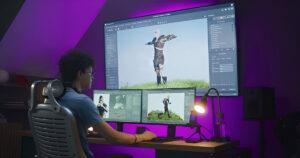Animation has always been a powerful storytelling medium, evolving with new technologies and creative techniques. From the earliest hand-drawn cartoons to today’s advanced digital tools, the field has continually reinvented itself. Yet, one style has remained timeless in its charm and appeal—Claymation.
Even in an age dominated by Motion Capture, movement animation, and sleek motion graphics, Claymation continues to enchant audiences. It proves that artistry and storytelling matter just as much as technology. In this article, we’ll explore how Claymation thrives in 2025, its role in modern media, and how it coexists with cutting-edge animation techniques.
What is Claymation?
Claymation, a form of stop-motion animation, involves creating characters and sets out of clay and capturing their movement frame by frame. By slightly adjusting the clay figures between shots, animators create the illusion of motion.
Some of the most iconic films and series, like Wallace & Gromit and The Nightmare Before Christmas, have used Claymation to craft worlds filled with texture, charm, and a handcrafted feel that computer-generated imagery often struggles to replicate.
Claymation’s Unique Appeal
Unlike hyper-polished 3D Animation or motion graphics, Claymation stands out with its imperfections. Each fingerprint left on a clay character or uneven surface detail adds authenticity, reminding viewers that human hands shaped the story.
This tactile quality creates a sense of warmth and nostalgia. In an age where digital content dominates, audiences increasingly value artistry that feels “real.” That’s why brands, filmmakers, and educators continue to embrace Claymation in 2025.
Claymation vs. Motion Capture
While Claymation celebrates handcrafted storytelling, Motion Capture represents the cutting edge of digital animation. Motion Capture records real actors’ movements and translates them into digital characters, allowing for hyper-realistic movement animation.
For example, blockbuster films use Motion Capture to animate lifelike creatures and characters with intricate details. Meanwhile, Claymation’s slower, handcrafted process leans into its artistic imperfections rather than striving for realism.
Both techniques serve unique purposes:
-
Motion Capture excels in creating realism and fluid action.
-
Claymation thrives when the goal is charm, uniqueness, and emotional depth.
Together, they prove that animation is not a competition between old and new but a spectrum of techniques offering endless storytelling possibilities.
Movement Animation in Claymation
While Claymation may not rely on Motion Capture, it still demands a deep understanding of movement animation. Each clay figure must be carefully adjusted to simulate natural motion—walking, running, or even subtle gestures like blinking.
Animators working with clay often study real-life motion to ensure authenticity. The result is a style of animation that feels both whimsical and grounded. It may lack the seamlessness of digital movement animation, but that’s part of its charm—it feels human, relatable, and deeply personal.
Claymation Meets Motion Graphics
Interestingly, Claymation has also merged with motion graphics in modern media. Advertisers and content creators now combine clay stop-motion with digital overlays, text, and animated effects to produce eye-catching content.
For example:
-
Brands use Claymation figures with animated motion graphics for quirky commercials.
-
Social media campaigns blend handcrafted visuals with sleek typography to grab attention.
-
Educational content pairs Claymation’s warmth with the clarity of digital infographics.
This hybrid approach allows Claymation to remain relevant in industries where digital precision is essential.
Claymation in 2025: Modern Applications
Far from being outdated, Claymation is thriving in multiple industries:
-
Film & TV – Independent filmmakers continue to embrace Claymation for its artistry and ability to stand out in a crowded digital market.
-
Advertising – Brands use Claymation in ads to evoke nostalgia and differentiate themselves from competitors relying solely on digital motion graphics.
-
Education – Claymation makes complex ideas fun and engaging for students, particularly in science and history lessons.
-
Social Media – Short-form Claymation clips are highly shareable, standing out in feeds filled with polished 3D or CGI content.
The Future of Claymation
As technology advances, some worry that traditional techniques like Claymation will fade away. But history proves otherwise. Instead of disappearing, Claymation adapts, finding new ways to coexist with innovations like Motion Capture and motion graphics.
Studios now use digital tools to streamline Claymation production—editing frames, enhancing colors, or adding effects. Yet, the core process of molding and animating clay remains unchanged. This fusion of analog craftsmanship and digital efficiency ensures that Claymation will continue to inspire future generations of animators.
Why Claymation Still Matters
In 2025, audiences crave authenticity. While Motion Capture wows us with lifelike movement animation and motion graphics deliver sleek visuals, Claymation reminds us of the power of creativity and human touch.
It’s not about competing with technology—it’s about storytelling. Claymation connects on an emotional level, proving that in animation, heart and craft are just as important as innovation.
Conclusion
Claymation is more than a nostalgic technique—it’s a timeless art form that continues to captivate audiences in the digital age. By embracing both tradition and innovation, it has carved out a unique space in modern storytelling. Whether paired with motion graphics, compared with Motion Capture, or celebrated for its handcrafted movement animation, Claymation remains a vital part of the animation industry.
As we move further into 2025, one thing is clear: in a world dominated by digital tools, Claymation proves that handmade artistry still has a powerful role in shaping the future of storytelling.

